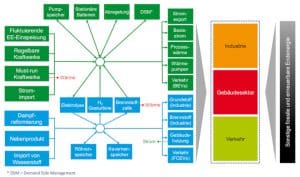The energy system of the future faces numerous challenges with its increasing decarbonisation, the further expansion of renewable energies and the coupling of the electricity, heat, transport and industrial sectors.
At the same time, however, the advancing energy turnaround also offers economic opportunities through additional added value, new jobs and a reduction in dependence on imports of fossil energy sources. In this context, hydrogen produced from renewable energies can be seen as an important pillar in achieving the energy policy triangle of climate protection, safety of supply and economic efficiency.
The Hydrogen Study NRW, which was commissioned by the state of North Rhine-Westphalia and carried out by Ludwig-Bölkow-Systemtechnik (LBST), focuses on the economic and climate-relevant potential of hydrogen in a future energy system in Germany and NRW. On the basis of a differentiated evaluation of hydrogen, the study provides well-founded insights into the value of hydrogen as an energy source in a future energy system. The cost-optimized design and operation of the future energy system were modelled. On the other hand, on the basis of these results, further economic effects of hydrogen in terms of value creation potential were examined in more detail.
Integrated modelling of the energy system
The evaluation of the potentials of hydrogen is basically based on a comparison of two applications with low or high H2 demand. On the one hand, the focus on electrification is predominantly on direct electrical end applications, with electricity being the main energy source, so that the power grid has to be expanded accordingly. The lower demand for hydrogen, for example for material use in industry, is served locally by electrolysis. On the other hand, the focus on hydrogen on a larger scale uses H2-based end applications supplied by a dedicated H2 pipeline network.
The study considers a total of six scenarios that differ for the three GHG reduction targets (GHG = greenhouse gas) across all sectors from 55 percent in 2030 and 80 percent and 95 percent in 2050, respectively, on the basis of the two application cases. The GHG target of 95 percent means a complete decarbonization of the remaining energy system due to unavoidable residual emissions, for example from agriculture or cement production.
…
read more in H2-international October 2019
Authors:
Dr. Jan Michalski, Dr.-Ing. Ulrich Bünger, Matthias Altmann, Werner Weindorf
all: Ludwig-Bölkow-Systemtechnik GmbH, Ottobrunn


























0 Comments